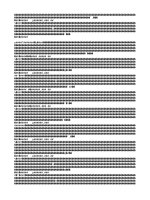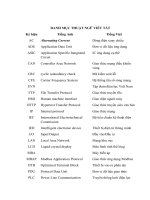Điện tử viễn thông near field communication in cell phones khotailieu
Bạn đang xem bản rút gọn của tài liệu. Xem và tải ngay bản đầy đủ của tài liệu tại đây (525.62 KB, 26 trang )
Near Field Communication in Cell
Phones
Annika Paus
24.07.2007
Seminararbeit
Ruhr-Universit¨at Bochum
Chair for Communication Security
Prof. Dr.-Ing. Christof Paar
Contents
1 Introduction
1
2 Standards and Compatibility
3
3 Technology Overview
3.1 Communication Modes: Active and Passive .
3.2 Coding and Modulation . . . . . . . . . . .
3.2.1 Manchester Code . . . . . . . . . . .
3.2.2 Modified Miller Code . . . . . . . . .
3.3 Initiator and Target . . . . . . . . . . . . .
3.4 Collision Avoidance . . . . . . . . . . . . . .
3.5 General Protocol flow . . . . . . . . . . . . .
.
.
.
.
.
.
.
5
5
6
6
7
7
7
8
4 Comparison with other Technologies
4.1 NFC and RFID . . . . . . . . . . . . . . . . . . . . . . . . . . . .
4.2 Comparison with Bluetooth and Infrared . . . . . . . . . . . . . .
11
11
11
5 Security Aspects
5.1 Eavesdropping . . . . . . .
5.2 Data Destruction . . . . .
5.3 Data Modification . . . . .
5.4 Data Insertion . . . . . . .
5.5 Man-in-the-Middle-Attack
13
13
14
15
16
16
6 Conclusion
.
.
.
.
.
.
.
.
.
.
.
.
.
.
.
.
.
.
.
.
.
.
.
.
.
.
.
.
.
.
.
.
.
.
.
.
.
.
.
.
.
.
.
.
.
.
.
.
.
.
.
.
.
.
.
.
.
.
.
.
.
.
.
.
.
.
.
.
.
.
.
.
.
.
.
.
.
.
.
.
.
.
.
.
.
.
.
.
.
.
.
.
.
.
.
.
.
.
.
.
.
.
.
.
.
.
.
.
.
.
.
.
.
.
.
.
.
.
.
.
.
.
.
.
.
.
.
.
.
.
.
.
.
.
.
.
.
.
.
.
.
.
.
.
.
.
.
.
.
.
.
.
.
.
.
.
.
.
.
.
.
.
.
.
.
.
.
.
.
.
.
.
.
.
.
.
.
.
.
.
.
.
.
.
.
.
.
19
1 Introduction
Near Field Communication (NFC) is a technology for contactless short-range
communication. Based on the Radio Frequency Identification (RFID), it uses
magnetic field induction to enable communication between electronic devices.
The number of short-range applications for NFC technology is growing continuously, appearing in all areas of life. Especially the use in conjunction with
mobile phones offers great opportunities. The main applications are:
• payment & ticketing
NFC enables users to make fast and secure purchases, go shopping with
electronic money, and also to buy, store and use electronic tickets, such as
concert/event tickets, plane tickets, travel cards, etc.
• electronic keys
For example, these can be car keys, house/office keys, etc.
• identification
In addition, NFC makes it possible to use mobile phones instead of identity documents. In Japan, for example, student IDs can be stored on cell
phones, which allows the students to electronically register for classes, to
open locked campus doors, buy food at the school cafeteria, borrow books,
and even get discounts at local movie theaters, restaurants, and shops.
• receive and share information
The data stored on any tagged object (e.g. a DVD box or a poster) can be
accessed by mobile phones in order to download movie trailers, street-maps,
travel timetables etc.
• set-up service
To avoid the complicated configuration process, NFC can be used for the
set-up of other longer-range wireless technologies, such as Bluetooth or
Wireless LAN.
Up to now the convenience of NFC is mostly used in Asia, for instance in Japan
or South Korea, where paying with a mobile phone or a NFC-smartcard already
belongs to everyday life. In September 2006, ABI research predicted that by
2011, about 30% of the mobile phones in the world (about 450 million phones)
would be NFC-enabled.
2
Introduction
In this paper we will discuss the characteristics of NFC. We start with the underlying Standards and Compatibility in Chapter 2, before we will consider the
basic technology capabilities in Chapter 3. Chapter 4 deals with the correlation
between NFC and RFID and confronts NFC with Bluetooth and infrared. Chapter 5 observes the Near Field Communication from the security point of view,
considering different types of attack. In Chapter 6 the major results of this work
are summarized.
2 Standards and Compatibility
Near Field Communication is an open platform technology, developed by Philips
and Sony. NFC, described by NFCIP-1 (Near Field Communication Interface
and Protocol 1), is standardized in ISO 18092 [1], ECMA 340[2] as well as in
ETSI TS 102 190[3]. These standards specify the basic capabilities, such as the
transfer speeds, the bit encoding schemes, modulation, the frame architecture,
and the transport protocol. Furthermore, the active and passive NFC modes
are described and the conditions that are required to prevent collisions during
initialization.
Todays NFC devices do not only implement NFCIP-1, but also NFCIP-2, which
is defined in ISO 21481 [4], ECMA 352 [5] and ETSI TS 102 312[6]. NFCIP-2
allows for selecting one of three operating modes:
• NFC data transfer (NFCIP-1),
• proximity coupling device (PCD), defined in ISO 14443 [7], and
• vicinity coupling device (VCD), defined in ISO 15693 [8].
NFC devices have to provide these three functions in order to be compatible
with the main international standards for smartcard interoperability, ISO 14443
(proximity cards, e.g. Philip’s Mifare), ISO 15693 (vicinity cards) and to Sonys
FeliCa contactless smart card system. Hence, as a combination of smartcard and
contactless interconnection technologies, NFC is compatible with today’s field
proven RFID-technology. That means, it is providing compatibility with the
millions of contactless smartcards and scanners that already exist worldwide.
4
Standards and Compatibility
3 Technology Overview
NFC operates in the standard, globally available 13.56 MHz frequency band. Possible supported data transfer rates are 106, 212 and 424 kbps and there is potential
for higher data rates. The technology has been designed for communications up
to a distance of 20 cm, but typically it is used within less than 10 cm. This short
range is not a disadvantage, since it aggravates eavesdropping.
3.1 Communication Modes: Active and Passive
The NFC interface can operate in two different modes: active and passive. An
active device generates its own radio frequency (RF) field, whereas a device in
passive mode has to use inductive coupling to transmit data. For battery-powered
devices, like mobile phones, it is better to act in passive mode. In contrast to
the active mode, no internal power source is required. In passive mode, a device
can be powered by the RF field of an active NFC device and transfers data using
load modulation. Hence, the protocol allows for card emulation, e.g., used for
ticketing applications, even when the mobile phone is turned off.
This yields to two possible cases, which are described in Table 3.1. The communication between two active devices case is called active communication mode,
whereas the communication between an active and a passive device is called passive communication mode.
Communication
Mode
Active
Passive
Description
Two active devices communicate with each other.
Each device has to generate its own RF field,
if it wants to send data. The RF field is
alternately generated by one of the two devices.
In this mode the communication takes place
between an active and a passive device. The
passive device has no battery and uses the RF
field generated by the active device.
Table 3.1: Communication Configurations
In general, at most two devices communicate with each other at the same time.
However, as defined in [2], §11.2.2.3, in passive mode the initiator (see Section
6
Technology Overview
3.3) is able to communicate with multiple targets. This is realized by a time
slot method, which is used to perform a Single Device Detection (SDD). The
maximal number of time slots is limited to 16. A target responds in a random
chosen time slot that may lead to collision with the response of another target.
In order to reduce the collisions, a target may ignore a polling request set out
by the initiator. If the initiator receives no response, it has to send the polling
request again.
3.2 Coding and Modulation
The distinction between active and passive devices specifies the way data is
transmitted. Passive devices encode data always with Manchester coding and
a 10 %ASK1 . Instead, for active devices one distinguishes between the modified
Miller coding with 100% modulation if the data rate is 106 kbps, and the Manchester coding using a modulation ratio of 10% if the data rate is greater than
106 kbps. As we will discuss later the modulation ratio, defined in [1] is of high
importance for the security of the NFC data transfer.
106 kBaud
212 kBaud
424 kBaud
Active Device
Modified Miller, 100% ASK
Manchester, 10% ASK
Manchester, 10% ASK
Passive Device
Manchester, 10% ASK
Manchester, 10% ASK
Manchester, 10% ASK
Table 3.2: Coding and Modulation at different transfer speeds [10]
3.2.1 Manchester Code
The Manchester coding depends on two possible transitions at the midpoint of
a period. A low-to-high transition expresses a 0 bit, whereas a high-to-low transition stands for a 1 bit. Consequently, in the middle of each bit period there is
always a transition. Transitions at the start of a period are not considered.
Figure 3.1: Manchester Code
1
Amplitude-shift keying is a form of modulation that represents digital data as variations
in the amplitude of a carrier wave [11]
3.3 Initiator and Target
7
3.2.2 Modified Miller Code
This line code is characterized by pauses occurring in the carrier at different
positions of a period. Depending on the information to be transmitted, bits are
coded as shown in Figure 3.2. While a 1 is always encoded in the same way,
coding a 0 is determined on the basis of the preceded bit.
Figure 3.2: Modified Miller Code
3.3 Initiator and Target
Furthermore, it is important to observe the role allocation of initiator and target.
The initiator is the one who wishes to communicate and starts the communication. The target receives the initiator’s communication request and sends back
a reply. This concept prevents the target from sending any data without first
receiving a message. Regarding the passive communication mode, the passive
device acts always as NFC target. Here the active device is the initiator, responsible for generating the radio field. In the case of an active configuration
in which the RF field is alternately generated, the roles of initiator and target
are strictly assigned by the one who starts the communication. By default all
devices are NFC targets, and only act as NFC initiator device if it is required by
the application.
In the case of two passive devices communication is not possible (see Table 3.3).
Active
Passive
Initiator
Target
Possible
Possible
Not Possible Possible
Table 3.3: Possible Combinations Active/Passive with Initiator/Target ([9])
3.4 Collision Avoidance
Usually misunderstandings are rather rare, since the devices have to be placed
in direct proximity. The protocol proceeds from the principle: listen before talk.
8
Technology Overview
If the initiator wants to communicate, first, it has to make sure that there is no
external RF field, in order not to disturb any other NFC communication. It has
to wait silently as long as another RF field is detected, before it can start the
communication, after an accurately defined guard-time ([2], §11.1). If the case
occurs that two or more targets answer at exactly the same time, a collision will
be detected by the initiator.
3.5 General Protocol flow
As shown in Figure 3.3 the general protocol flow can be divided into the initialization and transport protocol. The initialization comprises the collision avoidance
and selection of targets, where the initiator determines the communication mode
(active or passive) and chooses the transfer speed.
As defined in [2], §12, the transport protocol is divided in three parts:
• Activation of the protocol, which includes the Request for Attributes and
the Parameter Selection.
• The data exchange protocol, and
• The deactivation of the protocol including the Deselection and the Release.
During one transaction, the mode (active and passive) and the role (initiator
and target) does not change until the communication is finished. Though, the
data transfer speed may be changed by a parameter change procedure. For further
details the reader may refer to the standards [1] or [2].
3.5 General Protocol flow
Figure 3.3: General initialization and transport protocol ([2])
9
10
Technology Overview
4 Comparison with other
Technologies
4.1 NFC and RFID
Basically, the technologies Radio Frequency Identification and Near Field Communication use the same working standards. However, the essential extension
of RFID is the communication mode between two active devices. In addition
to contactless smart cards (ISO 14443 [7]), which only support communication
between powered devices and passive tags, NFC also provides peer-to-peer communication. Thus, NFC combines the feature to read out and emulate RFID
tags, and furthermore, to share data between electronic devices that both have
active power.
4.2 Comparison with Bluetooth and Infrared
Compared to other short-range communication technologies, which have been integrated into mobile phones, NFC simplifies the way consumer devices interact
with one another and obtains faster connections. The problem with infrared, the
oldest wireless technology introduced in 1993, is the fact that a direct line of
sight is required, which reacts sensitively to external influences such as light and
reflecting objects. The significant advantage over Bluetooth is the shorter set-up
time. Instead of performing manual configurations to identify the other’s phone,
the connection between two NFC devices is established at once (<0,1s). Table
4.1 points out these different capabilities of NFC, Bluetooth and infrared. All
these protocols are point-to-point protocols. Bluetooth also supports point-tomultipoint communications. With less than 10 cm, NFC has the shortest range.
This provides a degree of security and makes NFC suitable for crowded areas.
The data transfer rate of NFC (424 kbps) is slower than Bluetooth (721 kbps),
but faster than infrared (115 kbps). In contrast to Bluetooth and infrared NFC
is compatible to RFID.
12
Comparison with other Technologies
Table 4.1: NFC compared with Bluetooth and IrDa [12]
5 Security Aspects
In this chapter, we want to analyze the security of NFC. In this context two very
interesting papers have been published. In [9] Ernst Haselsteiner and Klemens
Breitfuß discuss some threats and solution for the security of NFC, and also the
paper ”Security Aspects and Prospective Applications of RFID Systems” [13]
gives some useful information.
First of all it should be mentioned that the short communication range of a few
centimeters, though it requires conscious user interaction, does not really ensure
secure communication.
There are different possibilities to attack the Near Field Communication technology. On the one hand the different used devices can be manipulated physically.
This may be the removal of a tag from the tagged item or wrapping them in metal
foil in order to shield the RF signal. Another aspect is the violation of privacy.
If proprietary information is stored on a tag it is important to prevent from
unauthorized read and write access. As outlined in [13] read-only tags are secure
against an unauthorized write access. In the case of rewritable tags we have
to assume that attackers may have mobile readers and the appropriate software
which enable unauthorized read and write access if the reader distance is normal.
In this work we want to focus on attacks with regard to the communication
between two devices.
For detecting errors, NFC uses the cyclic redundancy check (CRC). This method
allows devices to check whether the received data has been corrupted.
In the following, we will consider different possible types of attacks on the NFC
communication. For most of these attacks there are countermeasures in order to
avoid or at least reduce the threats.
5.1 Eavesdropping
NFC offers no protection against eavesdropping. RF waves for the wireless data
transfer with an antenna enables attackers to pick up the transmitted Monitoring
data. In practice a malicious person would have to keep a longer distance in order
not to get noticed. The short range between initiator and target for a successful
communication is no significant problem, since attackers are not bound by the
same transmission limits. Consequently the maximum distance for a normal read
sequence can be exceeded. The question how close an attacker has to be located
to retrieve an usable RF signal is difficult to answer. As listed in [9], this is
14
Security Aspects
depending on a ”huge” number of parameters, such as:
• RF filed characteristic of the given sender device (i.e., antenna geometry,
shielding effect of the case, the PCB, the environment)
• Characteristic of the attacker’s antenna (i.e., antenna geometry, possibility
to change the position in all 3 dimensions)
• Quality of the attacker’s receiver
• Quality of the attacker’s RF signal decoder
• Setup of the location where the attack is performed (e.g., barriers like walls
or metal, noise floor level)
• Power sent out by the NFC device
Furthermore, eavesdropping is extremely affected by the communication mode.
That’s because, based on the active or passive mode, the transferred data is coded
and modulated differently (see Section 3.2). If data is transfered with stronger
modulation it can be attacked easier. Thus, a passive device, which does not
generate it’s own RF field is much harder to attack, than an active device. In
order to let the reader presume the risk resulting from eavesdropping, there are
given rough distances in [9]: ”When a device is sending data in active mode,
eavesdropping can be done up to a distance of about 10 m, whereas when the
sending device is in passive mode, this distance is significantly reduced to about
1 m.”
However, we assume that such attacks will occur since the required equipment
is available for everyone. Equipped with such an antenna a malicious person
that is able to passively monitor the RF signal may also extract the plain text.
Experimenting and literature research can be used to get the necessary knowledge.
Hence, the confidentiality of NFC is not guaranteed. For applications which
transmit sensitive data a secure channel is the only solution.
In [14] some more detailed information of this attack are given.
5.2 Data Destruction
An attacker who aspires data destruction intends a corruption of the communication. The effect is that a service is no longer available. Still, the attacker is not
able to generate a valid message. Instead of eavesdropping this is not a passive
attack. This attack is relatively easy to realize. One possibility to disturb the
signal is the usage of a so called RFID Jammer.
There is no way to prevent such an attack, but it is possible to detect it. NFC
devices are able to receive and transmit data at the same time. That means, they
can check the radio frequency field and will notice the collision.
5.3 Data Modification
15
5.3 Data Modification
Unauthorized changing of data, which results in valid messages, is much more
complicated and demands a thorough understanding. As we will point out in the
following, data modification is possible only under certain conditions. In order
to modify the transmitted data an intruder has to concern single bits of the RF
signal. As already mentioned in Section 3.2 data is send in different ways. The
feasibility of this attack, that means if it is possible to change a bit of value 0 to
1 or the other way around, is subject to the strength of the amplitude modulation.
If 100% modulation is used, it is possible to eliminate a pause of the RF signal,
but not to generate a pause where no pause has been. This would demand an
impracticable exact overlapping of the attackers signal with the original signal
at the receiver’s antenna. However, Near Field Communication technology uses
modulation of 100% in conjunction with the modified Miller coding which leads
to 4 possible cases (see Figure 5.1). The only case, where a bit might be changed
by an attacker is, where a 1 is followed by another 1. By filling the pause in two
half bit of the RF signal the decoder receives the signal of the third case. Due
to the agreement of the preceding bit the decoder would verify a valid one. The
other three cases are not susceptible to such an attack.
Figure 5.1: Bit modification of the Modified Miller Code
For NFC, a modulation ratio of 10% is always used together with Manchester
coding. In contrast to the 100% modulation, where really no signal is send in a
pause, here within a pause the RF signal is e.g. 82% of the level of the full signal.
Let’s assume, an attacker may increase the existing RF signal about 18% during
the whole session, without being noticed by the decoder. Then, the attacker is
able to change a zero to one by increasing the RF signal during the first half of
the signal period by another 18%, and also may change a bit of value one to zero
by simply stopping to send anything.
16
Security Aspects
Regarding the threat in summary: Except for one case, always Manchester
coding with 10% ASK is used for NFC data transfer. This represents the best
possible conditions for the malicious intention of modifying NFC data (compare
Table 3.2). This way of transmitting the data offers a modification attack on all
bits. The only exception are active devices transfering data at 106 kbps. In this
case the usage of the modified Miller coding with a modulation ratio of 100%
accomplishes that only certain bits can be modified.
In [9] three countermeasures are described. One possibility is the usage of the
active communication mode with 106 kbps. As mentioned above this would not
prevent, but at least reduce the risk of this attack. Furthermore, it is possible to
let the devices check the RF field as already described in Section 5.2. Denoted as
the ”probably best solution” is the use of a secure channel. This would provide
data integrity.
5.4 Data Insertion
This attack can only be implemented by an attacker, if there is enough time to
send an inserted message before the real device starts to send his answers. If a
collision occurs the data exchange would be stopped at once. In order to prevent
such attacks the device should try to answer with no delay. Alternatively, again
checking the RF field and also the secure channel can be used to protect against
attacks.
5.5 Man-in-the-Middle-Attack
In order to show that NFC is secure against a Man-in-the-Middle-Attack we have
to survey both, the active and the passive communication mode. In the following
we distinguish between device A and device B that are exchanging data.
In passive mode the active device (A) generates the RF field in order to send
data to a passive device (B). The aim of an intruder is to intercept this message
and prevent device B from receiving it. The next step would be to replace it
with a different message. The first step is possible, but can be detected if device
A checks the RF field while sending the message. However, the second one is
practically impossible. To send a message to device B the attacker would have
to generate his own RF field. Hence, the RF field of device A has to be perfectly
aligned which is not practically feasible.
In contrast to the passive mode, in active mode device A switches off the
RF field after sending a message. Now the attacker is confronted with another
5.5 Man-in-the-Middle-Attack
17
problem. Even though he may generate an RF field, he is not able to transfer a
message to device B that would not be recognized by device A, because device A
is waiting for a response from device B. Thus, device A is assigned with the task
to check if the received messages really come from device B.
Disregarding relay attacks, NFC provides good protection against a Man-inthe-Middle attack. This applies particularly if the passive communication mode
is used and the RF field is monitored by device A.
18
Security Aspects
6 Conclusion
In summary, Near Field Communication is an efficient technology for communications with short ranges. It offers an intuitive and simple way to transfer
data between electronic devices. A significant advantages of this technique is the
compatibility with existing RFID infrastructures. Additionally, it would bring
benefits to the setup of longer-range wireless technologies, such as Bluetooth.
With regard to the security of NFC, we discussed different attacks and possible
countermeasures to mitigate their impact. Despite the restriction of the range,
eavesdropping or data modification attacks can be carried out. But, disregarding relay attacks, NFC provides security against Man-in-the-Middle-Attacks. In
order to provide protection against these threats, the establishment of a secure
channel is necessary. For this purpose simply the well known DH key agreement
can be used, because Man-in-the-Middle-Attacks represent no threat. With a
secure channel NFC provides confidentiality, integrity and authenticity.
20
Conclusion
Bibliography
[1]
ISO/IEC 18092(ECMA-340): Information technology - Telecommunications and information exchange between systems - Near Field
Communication - Interface and Protocol (NFCIP-1). First Edition,
2004-04-01.
[2]
Ecma International: Standard ECMA-340, Near Field Communication Interface and Protocol (NFCIP-1), December 2004, URL:
/>
[3]
ETSI TS 102 190 V1.1.1:
Near Field Communication
(NFC) IP-1; Interface and Protocol (NFCIP-1) 2003-03, URL:
.
[4]
ISO/IEC 21481: Information technology Telecommunications and
information exchange between systems Near Field Communication
Interface and Protocol -2 (NFCIP-2). January 2005.
[5]
Ecma
International:
Standard ECMA-352,
Near
Field
Communication
Interface
and
Protocol
-2
(NFCIP-2),
December
2003,
URL:
/>
[6]
ETSI TS 102 312, V1.1.1: Electromagnetic compatibility and
Radio spectrum Matters (ERM);Normalized Site Attenuation (NSA)
and validation of a fully lined anechoic chamber up to 40 GHz 200405, URL: .
[7]
ISO/IEC 14443: Identification cards - Contactless integrated circuit cards - Proximity cards. 2001, URL: www.iso.ch.
[8]
ISO/IEC 15693: Identification cards - Contactless integrated circuit cards - Vicinity cards.
[9]
Ernst
Haselsteiner
and
Klemens
Breitfuss:
Security in near field communication (NFC),
Philips Semiconductors,
Printed handout of Workshop
on RFID Security
RFIDSec 06, July 2006, URL:









